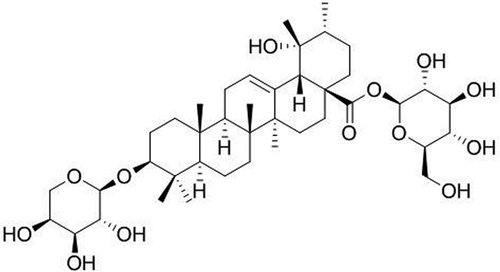 ?Mathematical formulae have been encoded as MathML and are displayed in this HTML version using MathJax in order to improve their display. Uncheck the box to turn MathJax off. This feature requires Javascript. Click on a formula to zoom.
?Mathematical formulae have been encoded as MathML and are displayed in this HTML version using MathJax in order to improve their display. Uncheck the box to turn MathJax off. This feature requires Javascript. Click on a formula to zoom.ABSTRACT
In this study, skin cream containing ziyuglycoside I isolated from Sanguisorba officinalis was manufactured and examined the protective effects of the skin cream against UVB-induced hairless mice. UVB-induced hairless mice were topically treated with the skin cream once a day for 5 weeks. Application of the skin cream did not exhibit side effect on body growth showing normal body weight and food efficiency in the mice. The skin cream treatment also was inhibited mRNA expression of interleukin (IL)-1β, matrix metalloproteinase (MMP)-2, MMP-9, and MMP-2 protein expression in the mice. Furthermore, the skin cream treatment inhibits epidermal wrinkle formation, wrinkle depth, wrinkle thickness, and collagen degradation in UVB-induced hairless mice. Therefore, the skin cream was able to play a role in the attenuation of photoaging caused by UVB irradiation via downregulation of mRNA expression of inflammatory cytokine IL-1β, MMP-2, MMP-9, and suppression of MMP-2 proteins expression.
GRAPHICAL ABSTRACT
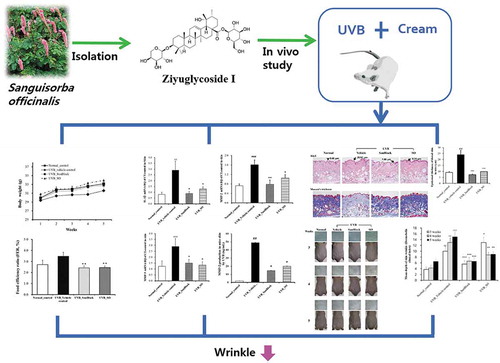
The cream containing ziyuglycoside I showed the protective effects against UVB-induced photoaging mice.
The skin, as the most vulnerable organ of the human body, functions as the first line of defense protecting the body against toxic chemicals, infections, and ultraviolet (UV) radiation [Citation1]. Excessive UVB irradiation penetrates the skin and generates intracellular reactive oxygen species (ROS), which consequently results in cellular oxidative stress and prolonged skin inflammation [Citation2]. Photoaged skin is characterized by loss of skin tone and resilience, roughness and dryness, irregular pigmentation, and deep wrinkles formation [Citation3].
UV-induced skin damage involves a variety of mechanisms, such as collagenase and inflammatory cytokine activities [Citation4]. Inflammatory cytokines such as interleukin (IL)-1β stimulate the accumulation of reactive oxygen species (ROS) that damage skin tissues and cells, and increase the expression of matrix metalloproteinases (MMPs) that destroy the structure and function of the extracellular matrix (ECM) by degrading collagen [Citation5].
Due to the fact that skin beauty is considered as overall well-being and the perception of physical health in humans, many efficient anti-aging strategies have been developed to prevent photoaging, such as sun avoidance, free radical neutralizers, herbs, and pharmacological agents with anti-aging properties [Citation6,Citation7]. Only two topical retinoids, tretinoin and tazarotene, among the many topical treatments have received US Food and Drug Administration approval for treating photoaging [Citation8].
Therefore, many research efforts have focused on identifying effective agents with antioxidant or anti-inflammatory properties that might have preventive or therapeutic value to combat photoaging. In a previous study, ziyuglycoside I isolated from a Sanguisorba officinalis root extract showed anti-wrinkle activity with inhibitory effect of elastase activity, expression of matrix metalloprotease-1 (MMP-1) and type I collagen synthesis in vitro [Citation9]. However, now there is no recorded effective anti-wrinkle activity of ziyuglycoside I with skin cream in UVB-induced hairless mice. In this study, we investigated the regulatory roles of skin cream manufactured with ziyuglycoside I isolated from S. officinalis with respect to photoaging-mediated skin damage caused by skin inflammation and MMPs in UVB-induced hairless mice.
Materials and methods
Reagents and equipment
All reagents were purchased from Sigma-Aldrich (St. Louis, MO, USA). All chemicals used in this study were of analytical grade quality and available commercially. 1H- and 13C-NMR spectra were recorded in CDCl3 on a Bruker DRX 300 spectrometer (Karlsruhe, Germany) at 600 and 150 MHz, using tetramethylsilane (TMS) as an internal standard, respectively, and chemical shifts are given in δ (ppm). UV spectra were obtained in methanol on a UVICON 933/934 spectrophotometer (Kontron Instrument, Milan, Italy) and mass spectra were obtained via either direct infusion or liquid chromatographic introduction into a Finnigan LCQ Advantage MAX ion trap mass spectrometer, equipped with a Finnigan Surveyor Modular HPLC system (Thermo Electron Co., USA). C18-Reversed phase (RP) silica gel (0.04–0.063 mm, Sigma-Aldrich; St. Louis, MO, USA) was used for column chromatography. Pre-coated silica gel plates (silica gel 60 F254, 0.25 and 0.5 mm thickness, Merck) were used for analytical thin-layer chromatography (TLC). A Hitachi L-6200 high-performance liquid chromatography (HPLC) (Hitachi, Tokyo, Japan) was used for isolation of active principles. YMC pack ODS-AM analytical column (250 × 10 mm, 10 μm, Shisheido-Capcell Pak C18 UG120, Japan) was used.
Preparation of ziyuglycoside I
To obtain ziyuglycoside I, S. officinalis roots (3 kg) were extracted with 100% methanol at 70℃. The methanolic extract was chromatographed over HP-20 column chromatography using a stepwise gradient of MeOH-H2O (from 0% to 100% with 20% increments: 500 mL for each step), to yield five fractions (Fr.1 – Fr.5). Of these, Fr.3 was further purified over a YMC gel column chromatography eluting with a gradient from 20% to 100% MeOH in H2O, to yield six fractions. Fr.3–5 (eluted with 80% MeOH in H2O) conducted gel permeation chromatography and then subjected to semi-preparative HPLC [column, CAPCELLPAK C18 UG120 (Shiseido); injection volume, 25 μL, flow rate, 1 mL/min, temperature, 28°C; detector, UV 203 nm and mobile phase, 20–100% CH3CN] to yield compound 1 (1.5 g and purity of 95%). As shown in , the structure of compound 1 was confirmed as ziyuglycoside I through NMR and MS spectra analyses, and comparison with published literature data () [Citation10]. FAB-MS m/z: 789 [M + Na]+. 1H-NMR (500 MHz, CD3OD-d4) δ: 5.32 (1H, d, J = 8 Hz, glc-H1), 5.34 (1H, m, H-12), 4.27 (1H, d, J = 8 Hz, ara-H1), 3.15 (1H, dd, J = 12.0, 4.0 Hz, H-3), 2.50 (1H, s, H-18), 1.31 (3H, s, Me-27), 1.19 (3H, s, Me-29), 1.03 (3H, s, Me-23), 0.94 (3H, s, Me-25), 0.93 (3H, d, J = 8 Hz, Me-30), 0.83 (3H, s, Me-24), 0.78 (3H, s, Me-26). 13C-NMR (100 MHz, CD3OD-d4) δ: 39.9 (C-1), 27.2 (C-2), 90.8 (C-3), 40.2 (C-4), 57.0 (C-5) 19.4 (C-6), 34.2 (C-7), 41.3 (C-8), 48.4 (C-9), 37.9 (C-10), 24.6 (C-11), 129.7 (C-12), 139.6 (C-13), 42.6 (C-14), 29.6 (C-15), 26.5 (C-16), 49.6 (C-17), 55.0 (C-18), 73.6 (C-19), 42.9 (C-20), 27.4 (C-21), 38.3 (C-22), 28.6 (C-23), 16.9 (C-24), 16.0 (C-25), 17.6 (C-26), 24.7 (C-27), 178.5 (C-28), 27.0 (C-29), 16.6 (C-30), 95.8 (glc-C1), 73.9 (glc-C2), 78.3 (glc-C3), 71.1 (glc-C4), 78.6 (glc-C5), 62.4 (glc-C6), 107.1 (ara(p)-C1), 72.8 (ara(p)-C2), 74.3 (ara(p)-C3), 69.5 (ara-C4), 66.3 (ara-C5).
Manufacture of skin cream
The composition of skin cream manufactured with ziyuglycoside I isolated from S. officinalis roots presented in . First, A materials [glycerin, 1,3-butylene glycol, carbopol 940 (2%), disodium EDTA and distilled water] were mixed in a mix tank with a Homo Disper (1,200 rpm and 65°C; premix, japan) and added B material [potassium hydroxide (KOH, 85%)] until the specimen attains uniform phase stage completely. Then C materials [Cetyl ethylhexanoate, liquid paraffin KF-70, cetyl alcohol (Kacol 6098), arlacel 165, cetyl stearyl alcohol (Lanette O Gesch) and glycerin monostearate (K.M. #205C)] were dissolved in a soluble tank with a Homo Disper (400 rpm and 75°C). The dissolved A, B, and C materials were emulsified in an emulsion tank with the Homo Disper (3,500 rpm and 75°C) and cooled into 50°C. D materials were mixed with the emulsified mixtures and cooled into 30°C. The vehicle was prepared with the same composition of skin cream except for ziyuglycoside I. SunBlock was prepared with the same composition of skin cream containing retinoic acid as a substitute for ziyuglycoside I.
Table 1. Formulation of skin cream for anti-photoaging effect.
Animal experiment
Seven-week-old female HRM-2 hairless mice were provided by Central Lab Animal Inc (Seoul, Korea). All mice were housed and maintained in the animal care facility at Daejeon University. The animal studies were performed according to protocols approved by the Animal Care Committee of the Institute of Daejeon University, South Korea (No. KW-160919–1). All experiments were performed in accordance with regulatory standards and guidelines.
The mice were divided into four groups, including a normal group (n = 5), UVB-vehicle group (n = 5), UVB-SunBlock (positive control) group (n = 5), and UVB-SO (test) group (n = 5). The minimal erythema dose (MED) on the skin of the mice was investigated. The mice were subjected to UVB radiation using a UVB lamp (Ieda Boeki, Tokyo, Japan). During the first week, 1 MED (100 mJ/cm2; irradiation time 1 min 70 s) of UVB was irradiated on the back of each mouse every day at a distance of 15 cm. From two to five weeks, UVB irradiation was performed three times a week with 2 MED (200 mJ/cm2; irradiation time 3 min 40 s) at a distance of 15 cm.
Starting the following day (day 1), 0.2 mL skin cream was applied topically, on a daily basis, for 5 weeks. The morphology was observed under digital camera (NX100; Samsung, Giheung, Korea), and images were recorded. Body weight and food efficiency ratio was monitored every week.
Wrinkle measurement
The wrinkles were measured by modifying the previous study [Citation11]. To investigate the wrinkle improvement of HRM-2 skin induced by UVB irradiation, the mice were transiently anesthetized using ethyl ether, and the wrinkles were measured using a Dermobella wrinkle analyzer (Chowis, Seongnam, Korea) 3, 4, and 5 weeks after UVB irradiation. The analyzer possessed skin measurement leans with 5-mega pixel image camera and various image modes composed of 20. The analyzer used measurement values from 0 to 100 subdivided for each analysis. The measurement values converted into wrinkle index from 0 to 30 by a formula:
Li is the length of wrinkle recognized in i.
Di is the average depth of wrinkle recognized in i.
Wrinkles were photographed at 400 × magnification using a USB digital microscope.
Real-time quantitative reverse transcription-polymerase chain reaction (RT-PCR)
Quantitative real-time PCR was performed to study the anti-photoaging effects of ziyuglycoside I on inflammatory cytokine gene expression [interleukin (IL)-1β] and matrix metalloproteinase (MMP) mRNA expression [MMP-2 and MMP-9] from skin tissue. Total cellular RNA was extracted from skin tissue by the phenol-chloroform method (RNAzolB; Tel-Test Inc., Friendswood, TX, USA). Three micrograms of total RNA were used for cDNA synthesis that was carried out using the ReverTraAce-α-cDNA synthesis kit (Toyobo Co., Osaka, Japan). The 7500 Fast Real-Time PCR system (Applied Biosystems, Foster City, CA, USA) used for real-time quantitative PCR with the following primer sequences. IL-1β, 50-CAACCAACAAGTGATATTCTCCATG-30 and 50-AGATCCACACTCTCAGCTGCA-30; MMP-2, 50-CAGGGAATGAGTACTGGGTCTATT-30 and 50-ACTCCAGTTAAAGGCAGCATCTAC-30; MMP-9, 50-AATCTCTTCTAGAGACTGGGAAGGAG-30 and 50-AGCTGATTGACTAAAGTAGCTGGA-30.
The TaqMan probe containing carboxyfluorescein dye (Applied Biosystems) was used to demonstrate mRNA gene expression. Mouse glyceraldehyde-3-phosphate dehydrogenase probe set (4352339E, VIC/MGB Probe, Probe Limited; Applied Biosystems) was used as internal standard. The final concentration of the primer was 200 nM.
The standard PCR conditions were 50°C for 2 min, 94°C for 10 min, then 40 cycles of 94°C for 1 min and 60°C for 1 min. The number of cycles in which the emission intensity of the sample rises above the baseline represents the relative quantity (RQ) and is proportional to the target concentration. Real-time PCR was analyzed according to the Applied Biosystems 7500 Fast Real-Time PCR system user manual. The relative quantitative value (RQ) of the target group was calculated by quantitative PCR.
Enzyme-Linked Immunosorbent Assay (ELISA)
Following the conclusion of the experiment, the expression level of MMP-2 protein in dorsal skin tissue extracted from each HRM-2 mouse was measured using MMP-2 ELISA kit (R&D System Inc., Minneapolis, MN, USA). One hundred microliters of MMP-2 coated antibody were dispensed into each microwell and incubated at 4°C for 16 h. Each well was washed with wash buffer prior to the addition of 200 µL of assay diluent and a 1-h incubation at room temperature. After diluting the standard solution and diluting the supernatant 20 times, the microplate was washed and 100 µL of standard and supernatant was added to each well and incubated for 2 h at room temperature. The microplate was washed, 100 µL of working detector was added to each well, and the microplate was incubated for 1 h at room temperature. After another wash, 100 µL of substrate solution was added to each well prior to incubation in a darkroom for 30 min at room temperature. Finally, 50 µL of stop solution was added to each well and the absorbance was measured at 450 nm on a microplate spectrophotometer.
Histological analysis
Histological analysis was performed to determine epidermal thickness and collagen fiber analysis. Dorsal skin samples of experimental group were obtained after 5 weeks of UVB exposure, fixed with 10% formalin and embedded in paraffin. Sections were stained with hematoxylin and eosin (H&E) and Masson’s trichrome to examine epidermal thickness and stain collagen fibers, respectively. Epidermal thickness and collagen deposition were measured at 100 × magnification using a digital microscope.
Statistical analysis
Results are expressed as means ± standard deviation. The data were analyzed using ANOVA and Duncan’s multiple range tests. Significance was indicated at a p < 0.05, <0.01, and <0.001.
Results
Body weight and food efficiency
Mice were applied topically with test essence for 5 weeks, body weight and food efficiency of four groups were measured at every day. Body weight and food efficiency of three groups did not show significant difference except for UVB-Vehicle control (,)). These results indicated that mice taken the skin cream manufactured with ziyuglycoside I did not exhibit side effect on body growth.
Figure 2. Body weight (a) and food efficiency ratio (b) in HRM-2 hairless mice applied the skin cream containing the ziyuglycoside I isolated from Sanguisorba officinalis topically for 5 weeks.
Normal, vehicle (negative) control group; positive control (SunBlock), skin cream application (test) group. SO, skin cream containing ziyuglycoside I isolated from Sanguisorba officinalis Linne. Values are expressed as means ± SD from two-independent experiments (n = 5). **Significantly different from UVB_Vehicle treatment (p < 0.01).
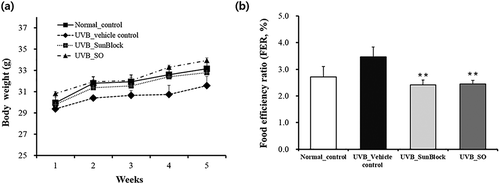
The skin cream manufactured with ziyuglycoside I inhibits mRNA expression of IL-1β, MMP-2, MMP-9, and proteins expression of MMP-2 in mice
To determine the effects of skin cream manufactured with ziyuglycoside I on an inflammatory cytokine (IL-1β), we investigated the effects of skin cream manufactured with ziyuglycoside I on mRNA expression of IL-1β. The expression of IL-1β was increased by UVB irradiation. However, the skin cream manufactured with ziyuglycoside I treatment decreased the expression of IL-1β ()).
Figure 3. Effects of the skin cream containing the ziyuglycoside I isolated from Sanguisorba officinalis on the expression of cytokine and proteins in ultraviolet-B (UVB)-induced hairless mice.
(a) mRNA expression of the inflammatory cytokine interleukin (IL)-1β; (b) mRNA expression of matrix metalloproteinase (MMP)-2; (c) mRNA expression of matrix metalloproteinase (MMP)-9; (d) MMP-2 protein expression. Values are expressed as means ± SD from two-independent experiments (n = 5). ##Significantly different from normal_control (p < 0.01). ###Significantly different from normal_control (p < 0.001). *Significantly different from UVB/Vehicle treatment (p < 0.05). **Significantly different from UVB_Vehicle control (p < 0.01).
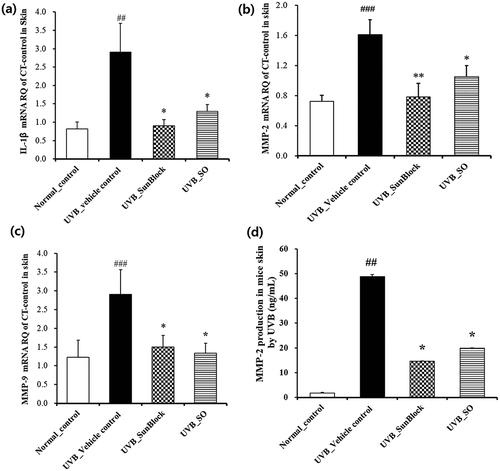
To confirm the effect of the skin cream manufactured with ziyuglycoside I on MMPs, MMP-2, MMP-9 mRNA expression, and MMP-2 proteins expression were measured. Expression of MMP-2, MMP-9 mRNA, and MMP-2 proteins were increased in the UVB-treated group compared to the normal control group (). Treatment with the skin cream manufactured with ziyuglycoside I suppressed the mRNA and protein expression relative to UV-vehicle group, with the difference being significant for MMP-2.
The skin cream manufactured with ziyuglycoside I inhibits UVB-induced photoaging in mice
The inhibitory effect of the skin cream manufactured with ziyuglycoside I on wrinkle formation was assessed in UVB-induced hairless mice. The mice were exposed to UVB for 5 weeks. The effect on skin morphology in terms of dorsal wrinkles and skin wrinkle depth was observed (). Skin wrinkle formation and wrinkle depth were increased in the UVB-induced group compared to the normal group. UVB-induced wrinkle depth was reduced in mice treated with the skin cream manufactured with ziyuglycoside I ().
Figure 4. Effect of the skin cream containing the ziyuglycoside I isolated from Sanguisorba officinalis on UVB-induced wrinkle formation in hairless mice.
(a) Features of dorsal skin of hairless mice exposed to UVB; (b) Mean of skin wrinkle depth. Values are expressed as means ± SD from two-independent experiments (n = 5). ##Significantly different from normal_control (p < 0.01). ###Significantly different from normal_control (p < 0.001). *Significantly different from UVB/Vehicle treatment (p < 0.05). **Significantly different from UVB_Vehicle control (p < 0.01). ***Significantly different from UVB_Vehicle control (p < 0.001).
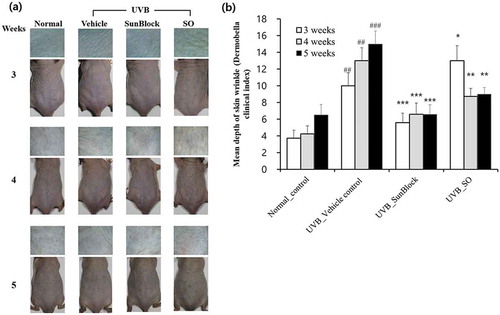
The skin cream manufactured with ziyuglycoside I inhibits increased epidermal thickness and collagen degradation by UVB-induced photoaging in mice
Histological analysis of dorsal skin of the hairless mice was done to evaluate the anti-photoaging effects of the skin cream manufactured with ziyuglycoside I on epidermal thickness and collagen degradation. H&E staining revealed significantly increased epidermal thickness in UVB irradiated mice. Mice treated with the skin cream manufactured with ziyuglycoside I displayed decreased skin thickness ()). Masson’s trichrome stain was used to identify collagen fibers, which stain blue. Staining of the collagen fibers was significantly decreased in the UVB control group compared to the normal group, whereas staining of the fibers was increased in tissue from mice treated with the skin cream manufactured with ziyuglycoside I compared to the UVB-vehicle group ()). These results suggest that the skin cream manufactured with ziyuglycoside I inhibits collagen degradation and modifies the effect of UVB irradiation.
Figure 5. Histological analyses of hematoxylin and eosin (H&E) and collagen degradation in hairless mouse skin.
(a) H&E stained sections; (b) Epidermal thickness; (c) Collagen fibers were stained using Masson’s trichrome stain. Values are expressed as means ± SD from two-independent experiments (n = 5). ##Significantly different from normal_control (p < 0.01). ***Significantly different from UVB_Vehicle control (p < 0.001).

Discussion
S. officinalis, which belongs to the family of Rosaceae, has been used for the treatment of inflammatory and metabolic diseases such as diarrhea, chronic intestinal infections, duodenal ulcers and internal hemorrhage [Citation12]. In addition, one of the components of the S. officinalis root extract, ziyuglycoside I, is reported anti-wrinkle activity with the inhibitory effect of expression of MMPs in vitro and increment of collagen synthesis in normal human fibroblast cells [Citation9]. Therefore, we expected the possible anti-wrinkle effect of ziyuglycoside I on UVB-induced hairless mice, and found that the skin cream manufactured with ziyuglycoside I, efficiently inhibits UVB-induced wrinkle formation, resulting in the decrease of mRNA expression of IL-1β, MMP-2, MMP-9, and proteins expression of MMP-2, in UVB-induced hairless mice.
Photoaging of the skin is associated with innate biologic aging processes and their interactions with environmental influences, such as sunlight and pollutants [Citation11]. Chronically sun-exposed skin is prone to increased oxidative damage mediated by ultraviolet (UV) irradiation and causes wrinkles and hyperpigmentation [Citation11]. For these reasons, natural compounds are traditionally used in the treatment of skin rejuvenating and photoprotective cosmetic formulations [Citation13]. In this study, we evaluated the anti-photoaging effect of skin cream manufactured with ziyuglycoside I isolated from S. officinalis on photoaging-mediated skin damage caused by skin inflammation and MMPs in UVB-induced hairless mice. Mice applied topically with test skin cream for 5 weeks did not exhibit side effect on body weight and food efficiency without significant difference in three groups except for UVB-Vehicle control ().
Chronic exposure to UVB increases intracellular reactive oxygen species (ROS), leading to oxidative DNA damage, and activation of inflammation and extracellular matrix (ECM) remodeling proteins including matrix metalloproteinases (MMPs) [Citation14]. Wrinkle formation is closely related to the degradation of ECM proteins via collagen fragmentation and MMP secretion [Citation15]. Some natural substances have been reported anti-photoaging effects via inhibition of inflammatory cytokines and MMP secretion [Citation16]. In our result, UVB-irradiation increased mRNA expression of IL-1β, MMP-2, MMP-9, and proteins expression of MMP-2, and then application of skin cream manufactured with ziyuglycoside I decreased them in UVB-induced hairless mice ().
Photoaged skin has deep wrinkles [Citation17,Citation18]. Photoaged skin also displays increased epidermal thickness and collagen degradation due to increased production of MMPs [Citation19]. In , mice irradiated with UVB for 3 weeks increased the depth of skin wrinkle and then application of the skin cream for 3 weeks did not decrease depth of skin wrinkle. However, application of the skin cream in mice irradiated with UVB for 4 or 5 weeks decreased depth of skin wrinkle. Therefore, anti-wrinkle effect of the skin cream manufactured with ziyuglycoside I will be showed by continuous using over 4 weeks. In , mice irradiated with UVB for 5 weeks increased skin thickness and collagen degradation in mice, the skin cream manufactured with ziyuglycoside I decreased thickness and collagen degradation in UVB-induced mice skin. From these results, we conclude that the skin cream manufactured with ziyuglycoside I may be a photoprotective candidate for skin care.
Conclusions
The skin cream containing ziyuglycoside I isolated from S. officinalis was manufactured and examined the protective effects of the skin cream against UVB-induced hairless mice. Our results demonstrated that the skin cream manufactured with ziyuglycoside I played protective roles in UVB-induced skin damages such as MMP-2, MMP-9 expression, IL-1β expression, and photoaging in mice. Further research is encouraged to investigate the clinical study of the skin cream.
Author contributions
MY Yun: In vivo laboratory work, HPLC analysis and study design; EY Bae: NMR conduction and structure assign of single compound; SW Lee: manuscript preparation and data analysis; SY Ly: in vivo laboratory work and obtained funding; SH Im: study design and isolation of single compound; HJ Choi: data analysis and writing. All authors read and approved the final manuscript.
Acknowledgments
This paper was supported (in part) by Research Funds of Chungnam National University in 2019.
Disclosure statement
No potential conflict of interest was reported by the authors.
References
- Hwa C, Bauer EA, Cohen DE. Skin biology. Dermatol Ther. 2011;24:464–470.
- Subedi L, Lee TH, Wahedi HM, et al. Resveratrol-enriched rice attenuates UVB-ROS-induced skin aging via downregulation of inflammatory cascades. Oxid Med Cell Longev. 2017;2017:8379539.
- Kligman LH, Kligman AM. The nature of photoaging: its prevention and repair. Photo-dermatol. 1986;3:215–227.
- Kim MS, Oh GH, Kim MJ, et al. Fucosterol inhibits matrix metalloproteinase expression and promotes type-1 procollagen production in UVB-induced HaCaT cells. Photochem Photobiol. 2013;89:911–918.
- Choi SH, Choi SI, Jung TD, et al. Anti-photoaging effect of Jeju Putgyul (Unripe Citrus) extracts on human dermal fibroblasts and ultraviolet B-induced hairless mouse skin. Int J Mol Sci. 2017;18:pii: E2052.
- Ganceviciene R, Liakou AI, Theodoridis A, et al. Skin anti-aging strategies. Dermatoendocrinol. 2012;4:308–319.
- Korac RR, Khambholja KM. Potential of herbs in skin protection from ultraviolet radiation. Pharm Rev. 2011;5:164–173.
- Antoniou C, Kosmadaki MG, Stratigos AJ, et al. Photoaging: prevention and topical treatments. Am J Clin Dermatol. 2010;11:95–102.
- Kim YH, Chung CB, Kim JG, et al. Anti-wrinkle activity of ziyuglycoside I isolated from a Sanguisorba officinalis root extract and its application as a cosmeceutical ingredient. Biosci Biotechnol Biochem. 2008;72:303–311.
- Chen DL, Cao XP. Pomolic acid derivatives from the root of Sanguisorba officinalis. Phytochem. 1992;31:1317–1320.
- Yaar M, Gilchrest BA. Aging versus photoaging: postulated mechanisms and effectors. J Invest Dermatol Symp Proce. 1998;3:47–51.
- Yoshida H, Yamazaki K, Komiya A, et al. Inhibitory effects of Sanguisorba officinalis root extract on HYBID (KIAA1199)-mediated hyaluronan degradation and skin wrinkling. Int J Cosmet Sci. 2019;41:12–20.
- Cavinato M, Waltenberger B, Baraldo G, et al. Plant extracts and natural compounds used against UVB-induced photoaging. Biogerontol. 2017;18:499–516.
- Finkel T, Holbrook NJ. Oxidants, oxidative stress and the biology of ageing. Nature. 2000;408:239–247.
- Naylor EC, Watson RE, Sherratt MJ. Molecular aspects of skin ageing. Maturitas. 2011;69:249–256.
- Chen CC, Chiang AN, Liu HN, et al. EGb-761 prevents ultraviolet B-induced photoaging via inactivation of mitogen-activated protein kinases and proinflammatory cytokine expression. J Dermatol Sci. 2014;75:55–62.
- Im AR, Song JH, Lee MY, et al. Anti-wrinkle effects of fermented and non-fermented cyclopia intermedia in hairless mice. BMC Complement Altern Med. 2014;14:424–429.
- Kim HS, Song JH, Youn UJ, et al. Inhibition of UVB-induced wrinkle formation and MMP-9 expression by mangiferin isolated from Anemarrhena asphodeloides. Eur J Pharmacol. 2012;689:38–44.
- Lee KO, Kim SN, Kim YC. Anti-wrinkle effects of water extracts of teas in hairless mouse. Toxicol Res. 2014;30:283–289.

